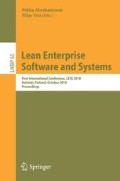Abstract
Distributed software development teams are common-place today. One good reason for distribution is the need to combine special skills or competencies from different locations. However, integrating skills flexibly is both a technical and a communication challenge. Lean and agile projects depend on direct communication. In this contribution, we investigate how agile teams can be distributed by adding a “remote partner” - and still maintain agile advantages. We analyze communication using the goal-question-metric paradigm (GQM) and apply it to a programming project, part of which was distributed. We discuss our insights on the minimal set of additions (technical and organizational) that are required to turn distributed while staying agile.
Access this chapter
Tax calculation will be finalised at checkout
Purchases are for personal use only
Preview
Unable to display preview. Download preview PDF.
References
Carver, J., Jaccheri, L., Morasca, S., Shull, F.: Issues in Using Students in Empirical Studies in Software Engineering Education. In: METRICS 2003: Proceedings of the 9th Intl. Symp. on Software Metrics, Sydney, Australia, pp. 239–249. IEEE Computer Society, Los Alamitos (2003)
Stapel, K., Lübke, D., Knauss, E.: Best Practices in eXtreme Programming Course Design. In: Proceedings of the 30th Intl. Conference on Software Engineering (ICSE 2008), Leipzig, Germany, pp. 769–776. ACM Press, New York (2008)
Poppendieck, M.: Principles of Lean Thinking. Technical Report, Poppendieck. LLC (2002)
van Solingen, R., Berghout, E.: The Goal/Question/Metric Method: A Practical Guide for Quality Improvement of Software Development. McGraw-Hill Publishing Company, New York (1999)
Molokken-Ostvold, K., Haugen, N.C.: Combining Estimates with Planning Poker–An Empirical Study. In: ASWEC 2007: Proceedings of the 2007 Australian Software Engineering Conference, Washington, DC, USA, pp. 349–358. IEEE Computer Society, Los Alamitos (2007)
Author information
Authors and Affiliations
Editor information
Editors and Affiliations
Rights and permissions
Copyright information
© 2010 Springer-Verlag Berlin Heidelberg
About this paper
Cite this paper
Meyer, S., Knauss, E., Schneider, K. (2010). Distributing a Lean Organization: Maintaining Communication While Staying Agile. In: Abrahamsson, P., Oza, N. (eds) Lean Enterprise Software and Systems. LESS 2010. Lecture Notes in Business Information Processing, vol 65. Springer, Berlin, Heidelberg. https://doi.org/10.1007/978-3-642-16416-3_14
Download citation
DOI: https://doi.org/10.1007/978-3-642-16416-3_14
Publisher Name: Springer, Berlin, Heidelberg
Print ISBN: 978-3-642-16415-6
Online ISBN: 978-3-642-16416-3
eBook Packages: Computer ScienceComputer Science (R0)

